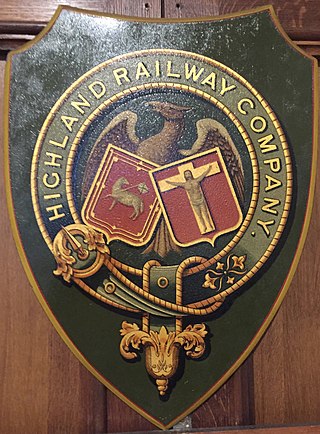
The Highland Railway (HR) was one of the smaller British railways before the Railways Act 1921, operating north of Perth railway station in Scotland and serving the farthest north of Britain. Based in Inverness, the company was formed by merger in 1865, absorbing over 249 miles (401 km) of line. It continued to expand, reaching Wick and Thurso in the north and Kyle of Lochalsh in the west, eventually serving the counties of Caithness, Sutherland, Ross & Cromarty, Inverness, Perth, Nairn, Moray and Banff. Southward it connected with the Caledonian Railway at Stanley Junction, north of Perth, and eastward with the Great North of Scotland Railway at Boat of Garten, Elgin, Keith and Portessie.

The Great North of Scotland Railway (GNSR) was one of the two smallest of the five major Scottish railway companies prior to the 1923 Grouping, operating in the north-east of the country. Formed in 1845, it carried its first passengers the 39 miles (63 km) from Kittybrewster, in Aberdeen, to Huntly on 20 September 1854. By 1867 it owned 226+1⁄4 route miles (364.1 km) of line and operated over a further 61 miles (98 km).

Dingwall railway station serves Dingwall, Scotland. It is located just south of the junction of the Far North Line and the Kyle of Lochalsh Line, and is managed and served by ScotRail. The station is 18 miles 58 chains (30.1 km) from Inverness, and is the zero point for the Kyle of Lochalsh Line. It is sited after Conon Bridge heading northbound, with the next station being either Garve or Alness.

Aviemore railway station serves the town and tourist resort of Aviemore in the Highlands of Scotland. The station, which is owned by Network Rail (NR) and managed by ScotRail, is on the Highland Main Line, 83 miles 31 chains from Perth, between Kingussie and Carrbridge, and is also the southern terminus of the Strathspey preserved railway.

Alness railway station is a railway station on the Far North Line, serving the town of Alness, on the Cromarty Firth, in the Highland council area of Scotland. The station is 28 miles 70 chains (46.5 km) from Inverness, between Dingwall and Invergordon. ScotRail, who manage the station, operate all services.

Forres railway station serves the town of Forres, Moray in Scotland. The station is managed and served by ScotRail and is on the Aberdeen–Inverness line, between Nairn and Elgin, measured 119 miles 42 chains (192.4 km) from Perth via the Dava route.

Elgin railway station is a railway station serving the town of Elgin, Moray in Scotland. The station is managed and served by ScotRail and is on the Aberdeen to Inverness Line, between Keith and Forres, measured 12 miles 18 chains (19.7 km) from Forres.
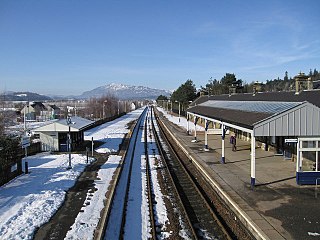
Kingussie railway station serves the town of Kingussie, Inverness-shire in the Highland Council Area of Scotland. The station is managed by ScotRail and is on the Highland Main Line, 71 miles 43 chains (115.1 km) from Perth, between Newtonmore and Aviemore.

Newtonmore railway station serves the village of Newtonmore, Highland, Scotland. The station is managed by ScotRail and is on the Highland Main Line. The station is 68 miles 62 chains (110.7 km) from Perth, between Dalwhinnie and Kingussie, and has a single platform which is long enough for a ten-coach train. It is currently the only station on the Highland Main Line to have one platform, although the former second platform can still be seen adjacent to the first platform.

Dalwhinnie railway station is a railway station serving the village of Dalwhinnie, Highland, Scotland. The station is managed by ScotRail and is on the Highland Main Line, 58 miles 47 chains (94.3 km) from Perth, between Blair Atholl and Newtonmore. There is a crossover at the south end of the station to allow trains to turn back if the line north to Newtonmore is closed.
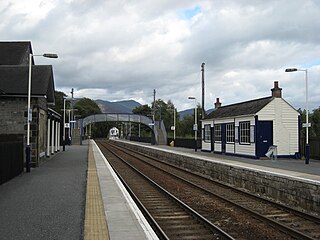
Blair Atholl railway station is a railway station serving the town of Blair Atholl, Perth and Kinross, Scotland. The station is managed by ScotRail and is on the Highland Main Line, 35 miles 9 chains (56.5 km) from Perth, between Pitlochry and Dalwhinnie. There is a crossover at the north end of the station to allow trains to turn back if the line south to Pitlochry is closed.
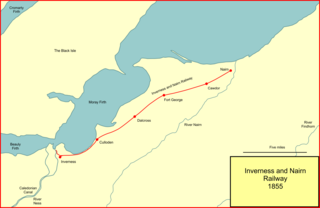
The Inverness and Nairn Railway was a railway company that operated between the burghs in the company name. It opened its line in 1855 and its passenger business was instantly successful. At first it was not connected to any other line. However it was seen as a first step towards connecting Inverness and Central Scotland, via Aberdeen and when feasible, directly southwards.

Gollanfield Junction was a railway station located at Gollanfield, to the west of Nairn, Scotland,. Opened in 1855 by the Inverness and Nairn Railway, it was initially named Fort George after the military base nearby.
The Inverness and Ross-shire Railway was a Scottish railway company formed in 1860 to build a line from Inverness to Invergordon. It opened in 1862 as far as Dingwall and in 1863 to Invergordon. It was extended to a Bonar Bridge station in 1864. It provided the basis for later extensions that eventually reached Thurso, forming the Far North Line. The Dingwall and Skye Railway branched off at Dingwall to reach the Kyle of Lochalsh.
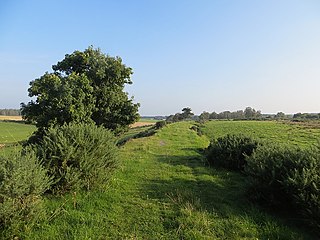
The Inverness and Perth Junction Railway (I&PJR) was a railway company that built a line providing a more direct route between Inverness and the south for passengers and goods. Up to the time of its opening, the only route was a circuitous way through Aberdeen. The I&PJR was built from a junction with the friendly Inverness and Aberdeen Junction Railway at Forres to the Perth and Dunkeld Railway at Dunkeld.
The Perth and Dunkeld Railway was a Scottish railway company. It was built from a junction with the Scottish Midland Junction Railway at Stanley, north of Perth, to a terminus at Birnam, on the south bank of the River Tay opposite Dunkeld.
The Inverness and Aberdeen Junction Railway (I&AJR) was a railway company in Scotland, created to connect other railways and complete the route between Inverness and Aberdeen. The Inverness and Nairn Railway had opened to the public on 7 November 1855 and the Great North of Scotland Railway (GNoSR) was building from Aberdeen to Keith. The I&AJR opened, closing the gap, on 18 August 1856.
The Strathspey Railway was a railway company in Scotland that ran from Dufftown to Boat of Garten. It was proposed locally but supported by the larger Great North of Scotland Railway (GNoSR), which wanted to use it as an outlet towards Perth. The GNoSR had to provide much of the funding, and the value of traffic proved to be illusory. The line opened in 1863 to Abernethy, but for the time being was unable to make the desired connection to the southward main line. Although later some through goods traffic developed, the route never achieved its intended purpose.

Dunphail railway station was opened with the Inverness and Perth Junction Railway in 1863.

Evanton railway station was a railway station on the Inverness and Ross-shire Railway, on the Inverness to Dingwall section. It was situated to the east of the village of Evanton.
















